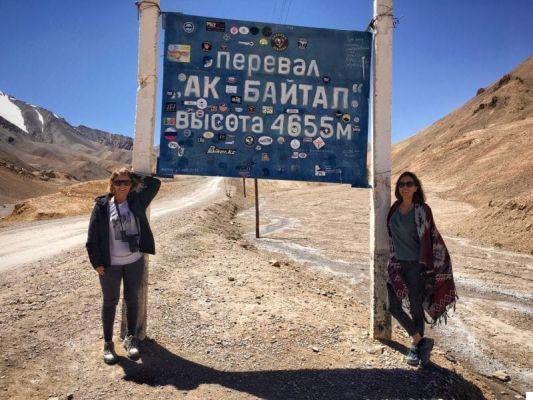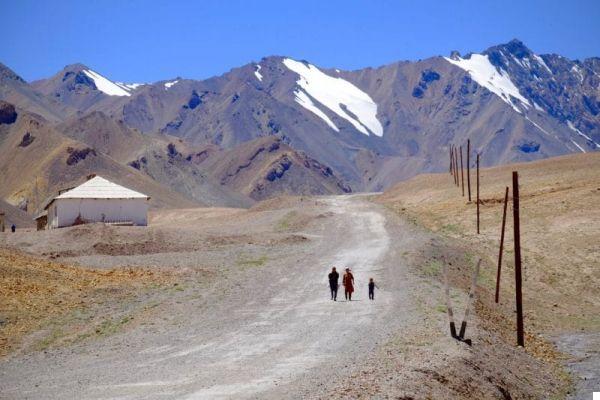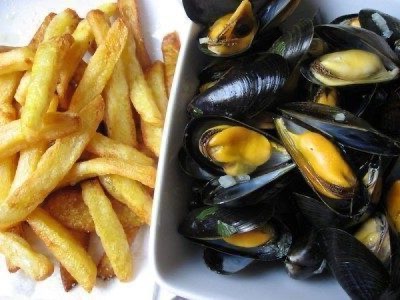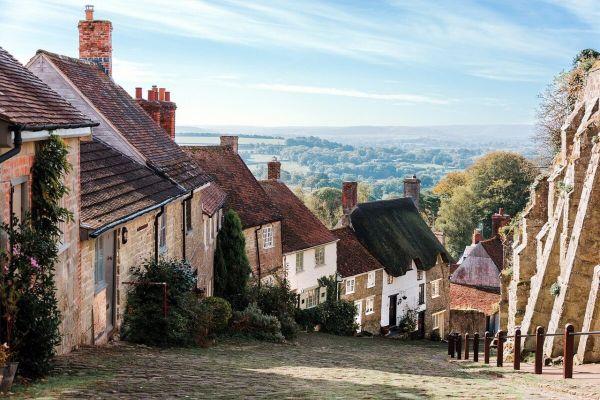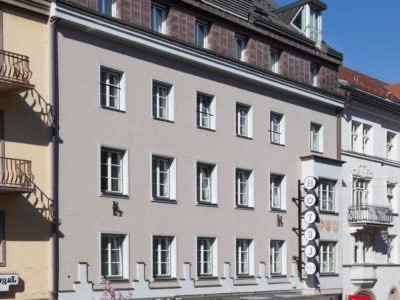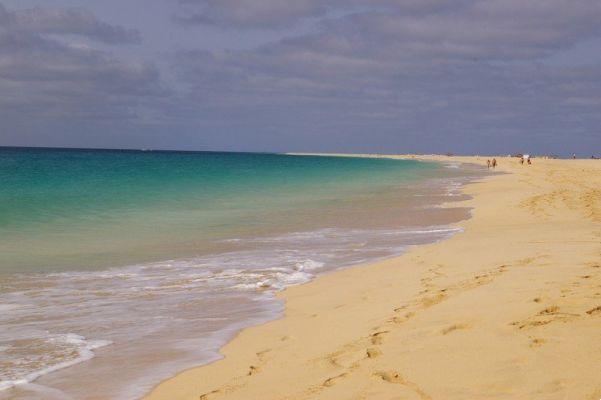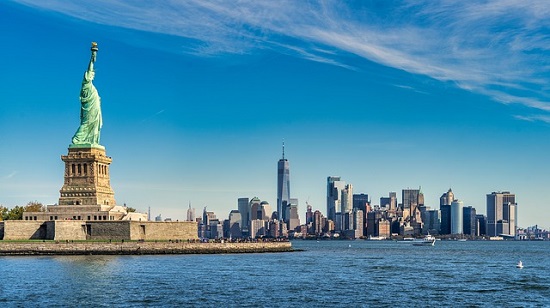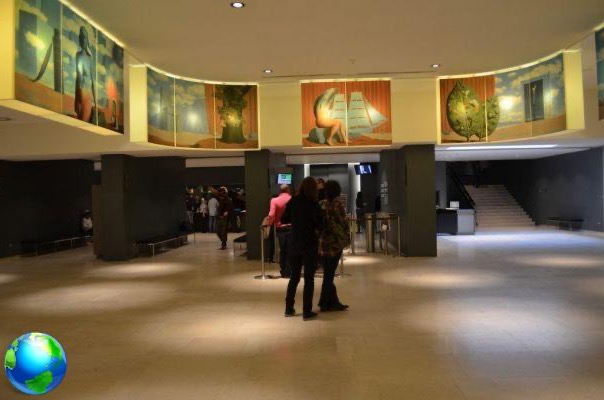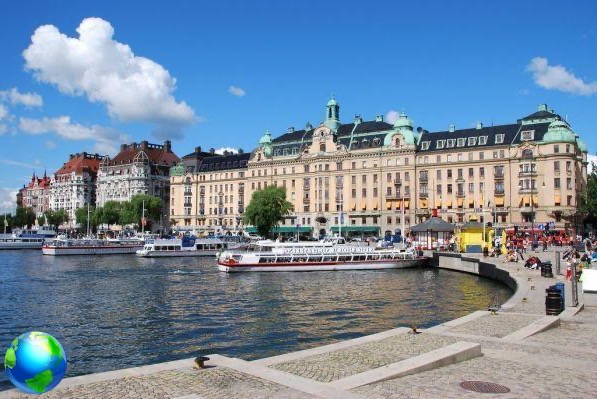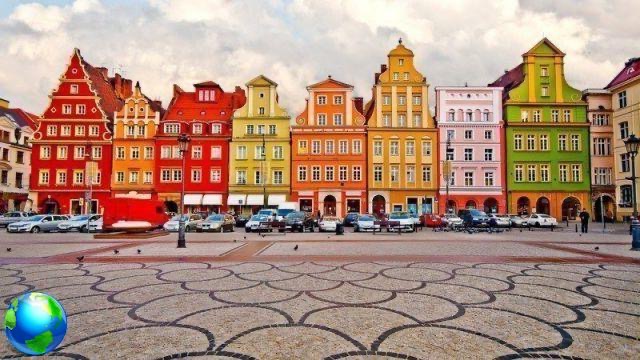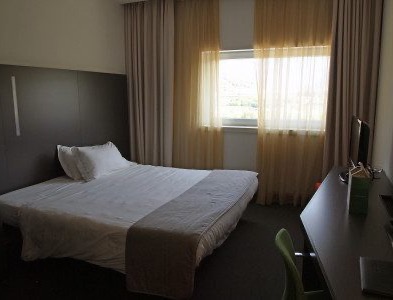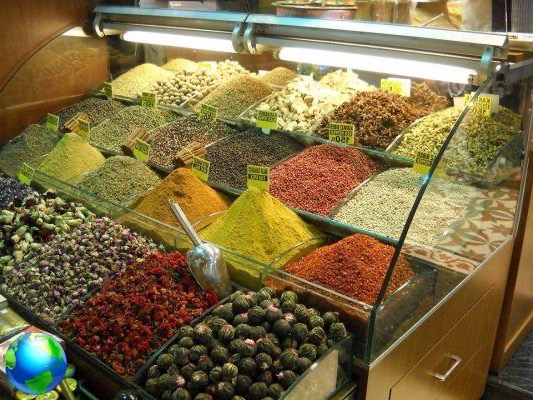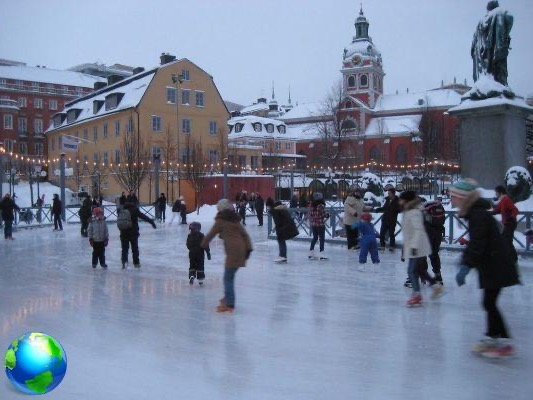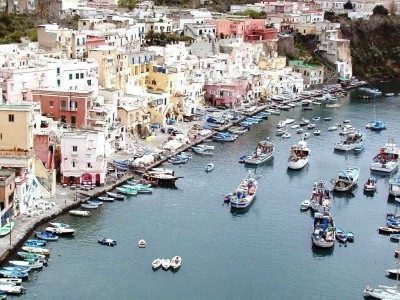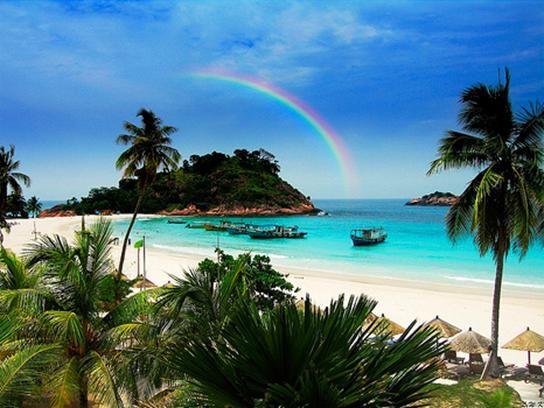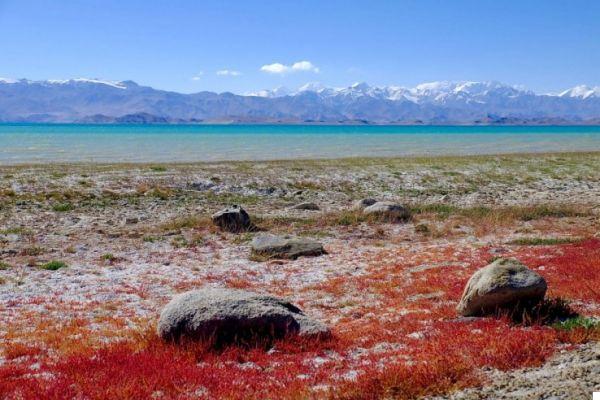
Tagi what? Probably among the 'stan countries the Tajikistan is the least known (not that the others are eh ..), and I admit that until 6 months ago I myself was unaware of its existence. When I then started studying the Silk Road I stumbled upon this isolated country in Central Asia and decided, on the contrary, that it would be the focus of my entire trip. The whole itinerary (which you can find in the article How to organize a trip to Central Asia) has been designed for Tajikistan, and more specifically, for the Pamir. From the very beginning I was captivated by the descriptions of these timeless places and I decided that I absolutely had to walk there too M41, the “famosa” Pamir Highway, the 1000 and more km of dirt road that connect Dushambe with Osh in Kyrgyzstan. In hindsight I could not have made a better choice: this state within a state nestled between Pakistan, Afghanistan, China and Kyrgyzstan literally bewitched me.
Il Pamir occupies all of eastern Tajikistan and is truly another country, has its own special access rules, speaks a different language (Farsi, as in Iran), professes a different religion (Shiite Islamism when the rest of the country is instead Sunni) and is inhabited by different ethnic groups. The Pamir represents 45% of the Tajik territory but hosts only 3% of the entire population; most of the inhabitants live in small villages nestled in the middle of suggestive valleys furrowed by rivers and surrounded by the very high snow-capped peaks of Afghanistan and Pakistan. It is an extremely remote region that remains isolated from the world for several months a year and has had to develop a particular lifestyle to survive in these conditions; despite this, the people of the Pamir are far from closed, they are extremely friendly and hospitable.
Along with Tibet, the Pamir trip is probably the trip on which I have met fewer tourists in my life, but those few I met were super-PRO travelers that I have never seen anywhere else: solo cyclists who come cycling from Europe, motorcyclists who enter and leave Pakistan or Afghanistan as if it were Riccione, team of the Mongol Rally (the famous charity rally from London to Ulaan Batar) .. so many incredible characters who told me crazy stories.
It is a journey that will remain in my heart for many reasons; certainly for the nature, the undisputed mistress and queen of these lands, but also for the millenary history and culture and, above all, for the humanity that I met there.
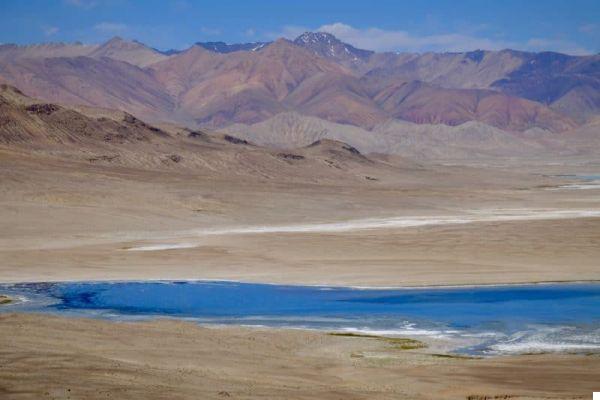
How to get a visa for Tajikistan
Since last year the Tajiko visa can be obtained online through this site filling in all the required fields.
At the end of the compilation, the electronic visa is paid by credit card. To enter Pamir you will also need to add the permesso for the so-called GBAO. The cost of the Tajiko visa is 20 dollars, to which you will have to add 50 for the GBAO. Pay close attention to the correctness of the data before sending it !!
The visa then arrives in pdf by e-mail after about 24 hours; it arrived in the SPAM folder for me so if it does not arrive, remember to check if by chance it did not end there. Print it at least in duplicate (in Pamir you will be asked several times a day at checkpoints / registration).
When to go to Pamir
The best time to visit Tajikistan and the Pamir is in summer, from June to September. In the capital Dushambe it can be very hot, but this is the only time of the year when it is possible to enter the Pamir. In winter, many sections of the Pamir Highway are submerged by snow and temperatures plummet between -20 ° and -45 °.
You may also be interested in: How to organize a trip to Central Asia (visas, itineraries, costs ..)
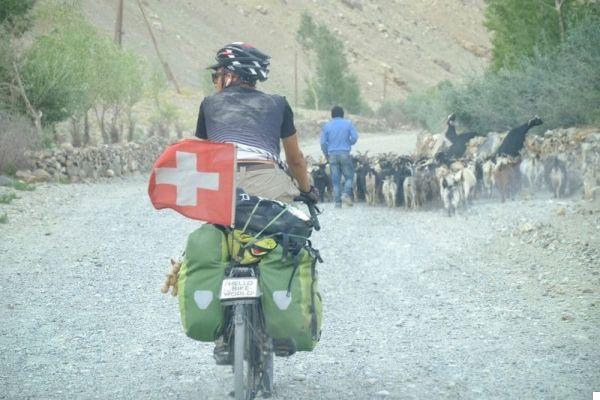
How to get to Pamir
Served by a limited number of flights and with few land border posts, Tajikistan is one of the most difficult Central Asian countries to reach. The best connections to reach Dushambe are via Turkey (with Turkish Airlines) or Russia (Aeroflot) and they are quite expensive. A cheaper alternative may be to fly to Tashkent (Uzbekistan) and enter from the Oybek border by land or to Osh (Kyrgyzstan). Many, like I did, put the Pamir trip within a larger route that includes Uzbekistan and Kyrgyzstan and, in this case, I recommend you travel from Dushambe to Osh and not vice versa, to see the sights. most beautiful and spectacular at the end of the trip.
How to get around in Pamir: agency or do-it-yourself
Unless you have months to spare, the best option to visit the Pamir is to rent a 4 × 4 jeep with driver. The Pamir Highway is largely unpaved and, at times, very dangerous so my advice is not to skimp too much on this expense. Obviously it is a fairly expensive service, but it will allow you to explore this beautiful region in total freedom as it deserves.
There are several agencies that offer the rental of jeeps with driver or tours with the guide. Before leaving I contacted several and in the end I chose the World Roof Tour . I was very happy with them, we had a new and large jeep (don't ask me for the model I don't remember), a good driver who spoke English (with a plus: he was a beautiful and very nice guy who, not surprisingly, also does the actor in China!) and we always slept in nice and comfortable places. The World Roof Tour turned out to be a serious and super professional agency. Among other things, I also asked for their help later, when I was in Kyrgyzstan, to find a jeep with driver for the Song Kol, and I found myself very well there too.
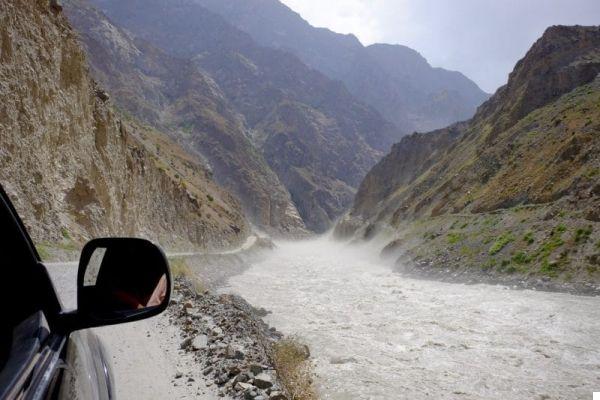
How much does a trip to Tajikistan and Pamir cost
For the whole trip to Tajikistan-Pamir (8 nights - from the Uzbek border to Osh, Kyrgyzstan) including jeep, driver, homestay nights and meals I spent 1100 dollars (which I paid directly there in cash), the equivalent of about 925 euros. The price drops significantly if you share the car with other travelers (and in this case the agency can help you find others or you can use the forum of the Caravanistan site).
It is a high figure especially for these countries, but the only way to reduce these costs would be to move by public transport (which only reaches Khorog in Pamir, after which there is nothing) and by hitchhiking, but cars. that pass on the Pamir Highway are very few and you risk having to wait for days before being loaded.
Security in Tajikistan
Reading the factsheet on Tajikistan on the Viaggiare Sicuri site of the Farnesina, they try to make you pass the desire to go there. Obviously they will have their good reasons and, after returning, I too agree that Tajikistan is potentially (like other 'stans) an unstable country and certainly the proximity to Afghanistan does not help stability. Having said that, I have not seen or experienced any dangerous situations on my skin, but I know well that they could occur (like everywhere in the world today). We have been told on several occasions that every year the Taliban and / or the Tajik separatists living in Afghanistan try to invade the Pamir by entering from Ishkashim. This year (2017) it happened in May but the attack was thwarted by the same Afghan police who killed them before they managed to enter the Pamiro village. They tell it as if it were a normal thing, as if the war / guerrilla were a normal thing, but I do not hide from you that it affected me a little. Before leaving for this trip, I had the idea of entering Afghanistan (and it would have been possible), but once there I didn't feel like it anymore. Going in for 1-2 days to get an Afghan stamp in my passport and visiting a couple of villages on the other side of the Pyanj River wouldn't have made much sense (not to mention that I would have had to shell out around $ 150). Afghanistan is a wonderful country but it is by no means a safe country unfortunately and Western tourists are the easiest "prey" to attack. Why go and look for it? I really hope that in the future it will be possible to visit it properly, more safely, from north to south.
Having said that, I believe Tajikistan is instead a safe country, probably more so than some European countries, and that you have to be really very unlucky to run into any problems.
Health insurance is required
In Tajikistan our health coverage is not valid. My advice is to always take a classic medical-luggage insurance that can cover you during the trip. I am very happy with many insurance companies, a site that compares the policies of different companies and proposes the most convenient policy for that particular trip. To do this you will have to enter the data relating to your trip (country, duration, etc.) and they will send you an email with the best proposal that you can then buy directly online.
You may also be interested in: What to see in Uzbekistan: the magic of the Silk Road 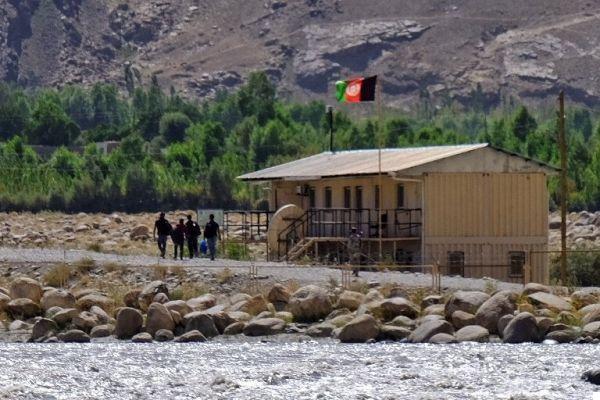
Travelogue: the Pamir highway from Dushambe to the border with Kyrgyzstan
Unlike what I usually do, I want to tell you about this trip in the form of a diary and, as you have already understood, I will tell you almost exclusively about the Pamir (if I had had more time, I would certainly have also gone to explore the Fan Mountains in northern Tajikistan, famous for the beautiful high altitude lakes).
Days 1-2
(Dushambe-Kalai Khum 370 km, 8h, strada asfaltata)
After a daring 8h transfer from Samarkand we finally arrive at Dushambe, the capital of Tajikistan. We arrived at the hotel when it was already dark and I couldn't get an idea of this city. From the little walk I took to go to dinner all in all it made a good impression on me, it seemed to me a modern city full of young people, but frankly I don't know if it is worth stopping here for a day.
After a refreshing night, the last in a hotel with Western comfort, we meet Ali, our driver, change the money and immediately set off. We are stopped several times by the police and Ali has to pull out some banknotes every now and then, but he hurries up with big smiles. The first 150 km (which are not yet on the M41) immediately give us beautiful views of Lake Nurek before reaching, in the early afternoon, the Pyanj river which will then keep us company for several days and which represents the natural border between Tajikistan and Afghanistan.
This stretch of road was recently paved by the Chinese and is in excellent condition. The road is beautiful, it slowly descends towards the river and it is amazing how this narrow but tumultuous river actually divides the Tajik road from a precarious and uncertain path on the Afghan side that connects tiny towns with stone houses. It is strange, Afghanistan is a few meters away but it is practically impossible to reach it; crossing the river would be suicide. At about 6 pm we reach Kalai-Khum, a small town on the river. We stay in a nice homestay (even with wifi) that overlooks the river and we sleep lulled by the noise of the water.
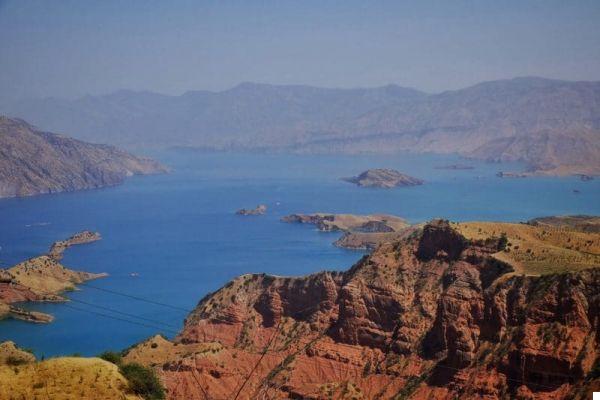
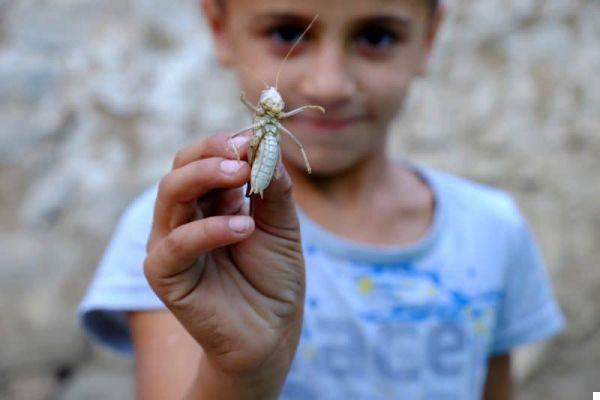
Day 3
(Kalai-Khum Khorog 240 km, 8h, strerrato)
Today we start dancing, from Kalai Khum the road is super scenic but unpaved and some sections are very dangerous. Two scarce lanes line the river without any kind of protection and often you can see flowers on the side of the road in remembrance of cars or trucks that have flown down. Here we enter the heart of the Pamir and we have to stop several times to be registered by the police; luckily you don't waste much time. At one of these police stations we meet an Italian team of the Mongol Rally with a Fiat Panda: they are two 20-year-old boys from Milan and they tell us that one of the 2 got his driving license just 4 months earlier ... high esteem!
We also meet a truck that has slipped halfway into the river (the driver is luckily saved) and blocks the passage for 3 days by creating a line of Chinese trucks on the other side; luckily the machines manage to pass!
After 8 hours of washing we arrive tired at Khorog, the "capital" of the Pamir. Before dining in our homestay there is time to take a tour of the town and a jump to the bazaar (where I am harassed by a drunk man who screams in front of my face). After dinner Ali takes us up a hill to the top of the town to hunt for shooting stars and to smoke (I will tell you, beyond what you can imagine, Afghan smoke is very light, much more than what comes home and which surely is cut with who knows what ... but don't tell anyone!).
PS If we had decided to enter Afghanistan we would have had to apply for a visa here in Khorog and it would have been issued in about 2 hours for a sum ranging between 100 and 150 dollars).
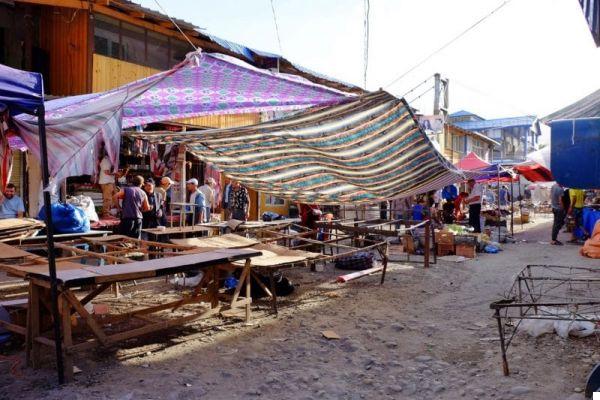
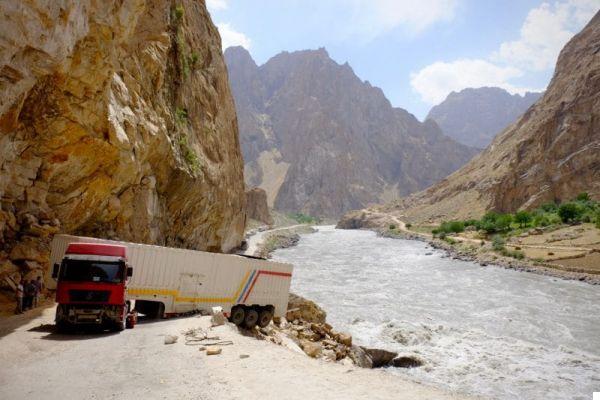
Day 4
(Khorog-Ishkashim 120 km, 4h sterrato)
The M41 starts from Khorog, but we, like almost everyone, have decided to follow the variant that instead descends towards the south to reach the Wakhan Valley (or Wakhan corridor as many call it).
This is the shortest leg of the trip, but the views are spectacular, especially when the snow-capped Hindukush peaks that mark the border between Afghanistan and Pakistan begin to appear.
Just before arriving at Ishkashim we pass in front of the Afghan border bridge which is deserted. It is Saturday and, until a few months ago, every Saturday there was a market here (beautiful they tell us) where Tajiks and Afghans could exchange goods. Unfortunately after the last attack by the Taliban it was closed and we just have to get to our guesthouse. Ishkashim is a small town, there is practically nothing but a lot of police. This is the most "sensitive" area of the Pamir, a lot of drugs pass through here and from here, every year, they try to attack the Taliban. We stay at the Hanis guesthouse, a very large place, where we meet another Mongol Rally team, this face made up of an English couple and a New Zealand boy. The British guy tells us that, without having decided before, he asked for his girlfriend's hand during the trip, in front of Hell's Gate in Turkmenistan and that they planned to get married in Ulaan Batar, at the arrival of the Mongol Rally. Organizing a wedding by email during a trip like this (when you barely have a telephone line) is not easy and I would be curious to know if in the end they made it! In addition to this they tell us several other anecdotes about the Rally, about the broken ferry on the Caspian Sea and about the biblical times it took to cross the Turkmen border.
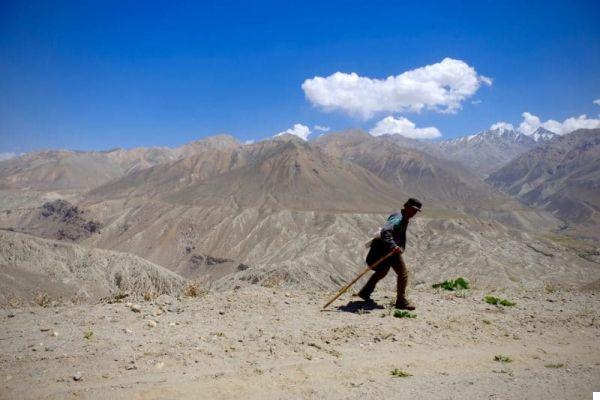
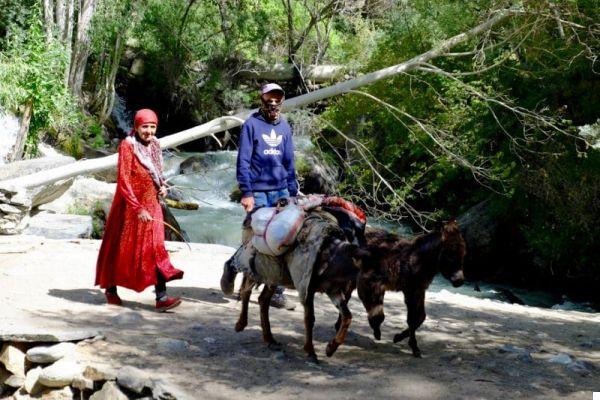

Day 5
(Ishkashim- Langar 140 km, 5h, sterrato)
We leave early to visit the fortresses of Kah-Kaa and Yamchum, two XNUMXth century fortresses that are located in an elevated position on the river and offer a spectacular view over the whole valley. In this area there are many fortresses that date back to the era of the Silk Road (Marco Polo himself passed here) and are still used as a guard post by the Tajik army to control the borders.
Above the fortress of Yamchum are the thermal springs of Bibi Fatima and local belief has it that by bathing in these waters at 40 °, women can increase their fertility. From there we go to visit the house-museum of the mystic Muabara Kadam in Yamg, a very interesting Pamir-style house and we stop for lunch in the guesthouse of Aydar, the keeper of the museum. Here we meet Zahara, an Iranian lady traveling with her son to the Pamir. Zahara tells us that they have lived in Leipzig for 30 years (her son was born there) because she had to flee Iran in the 90s: there was a price on her head. In the 80s she was an institutional representative in her high school in Tehran, organized demonstrations and distributed leaflets, and was considered a political dissident by the regime. She had to stay for 3 years locked in the house of family friends without ever being able to leave before deciding to escape with the help of her uncle who had fled years ago. After months of organizing, at the age of 19, alone, she managed to cross the Turkish border first on foot and then on horseback before she could be safe. Since then (30 years ago) he has only seen his parents twice and many of his Iranian "comrades" have died or have been in prison for years. She will never be able to return to Iran because she would be arrested. I still have goosebumps!
After that we come to shed where we spend the night in a very clean and nice homestay.
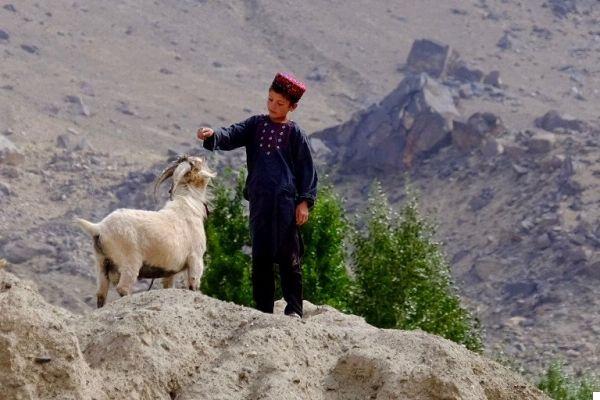

Day 6
(Langar- Murgab 300 km- 10h, dirt road)
Today begins with a walk (uphill) above Langar in search of some petroglyphs. Arriving more or less at the top we spot them but it is difficult to distinguish the ancient and authentic engravings from modern emulators. If nothing else, from up there there is a beautiful view over the whole valley and the Afghan mountains opposite.
We then get back into the car and it's time to leave the Pyanj river and Afghanistan, in 200 km we will start skirting China. The road that climbs to resume the Pamir Highway is spectacular, one of the most beautiful (and most dangerous) stretches, with a thousand sheer curves and incredible panoramic views. Before reaching the M41 again we can also see some Afghan caravans with camels, they are beautiful! From the M41 we deviate almost immediately to reach 2 beautiful ones laghi alpini salati: il Bulunkul e lo Yashil-kul. The surrounding landscape is lunar and desert and reminds me a lot of the Bolivian altiplanic lagoons. From here on, the temperatures are rigid (we are between 3500 and 4000 meters), we take out the duvet and head into the small Alinchur village for lunch (even if it is 4 in the afternoon) and we reach in the dark Murgab. We weren't supposed to sleep here tonight and didn't book anything; incredibly all the guesthouses are full and we can hardly find 2 beds to sleep on. To dine we go to the only hotel in the country, the Pamir Hotel, a meeting point for all backpackers, cyclists and motorcyclists and, surprisingly, we meet a group of Italian motorcyclists we met 4 years ago in Tibet on a mountain pass close to Everest !! Sometimes the world is really small.
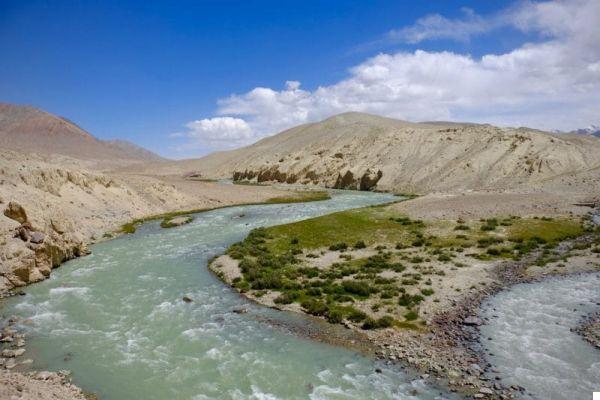
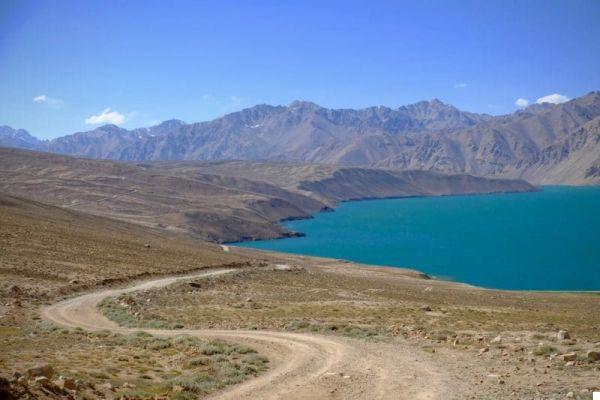
Day 7
(Murgab- Karakul 150 km-3h ugly asphalt and dirt road)
We go back to the Pamir Hotel for breakfast and we meet our new driver. From here on, although still in Tajikistan, mainly Kyrgyz live there and it is better to have a Kyrgyz driver (who will then accompany us to Osh). We say goodbye to Ali between emotion and tears and get back into the car; we overcome theAiktal Pass (4600 mt) before reaching Karakul with its salt alpine lake at 3900 mt. The lake has Caribbean colors and is surrounded by peaks that exceed 7000 meters .. I don't think I've ever seen anything like it!
We arrive in Karakul for lunch and spend the rest of the day walking along the lake and above all chatting with the incredible characters we meet in our guesthouse. There is Ricky, an Italian motorcyclist from Ravenna, who left Spain and will arrive in Japan, there are Sabrina and Massimiliano, also experienced motorcyclists who have traveled half the world, there are 4 Australian guys who are riding the M41 by bike .. in short, a concentrate of adventure!
When it gets dark, our eyes are captured by an incredible starry sky, there is no light pollution here and the Milky Way seems a few meters away from us.
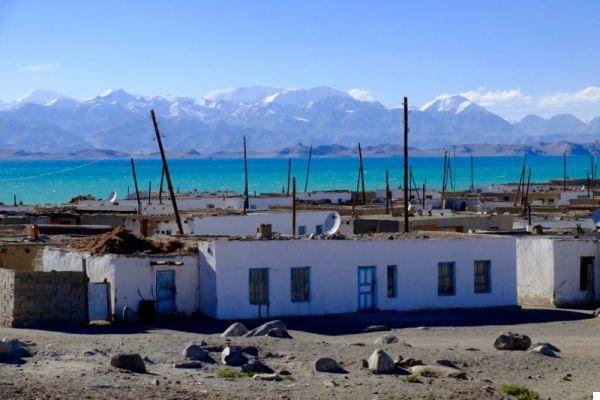
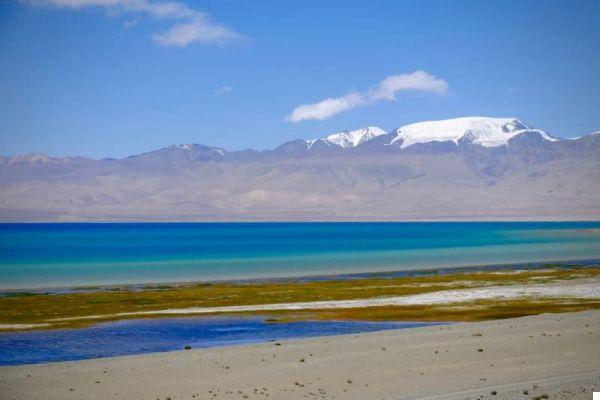
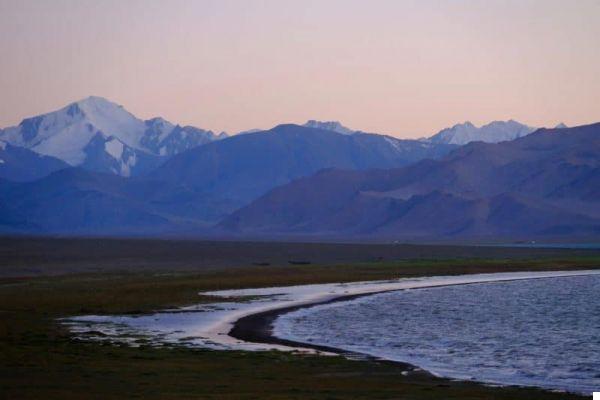
Day 8
(Karakul- Osh 277 km - 6/7 h asphalt)
We leave around 9 and reach the Kyzyl-Art Pass (4282 mt) where is the first one Tajik-Kyrgyz border post. Here we don't even have to get out of the car, the driver takes care of all customs procedures by himself. To reach the other border post and enter Kyrgyzstan, it takes us another hour. Here we have to wait, they let 1 car pass at a time and, when our turn comes, we have to get out of the car and let a drug dog (a cocker !!) check the car.
After the customs procedures I take a last look at the Pamir with tears in my eyes, this country has given me so much, indeed a lot, a thousand emotions that will remain in my eyes and in my heart for a lifetime. Thanks so much Pamir!
Entering Kyrgyzstan feels like entering Switzerland, the roads are beautiful, well paved and suddenly everything becomes much greener. We reach the hotel in Osh at 3 in the afternoon and we jump directly into the shower (we haven't washed for 2/3 days!). We are back in civilization and it is a strange feeling.
